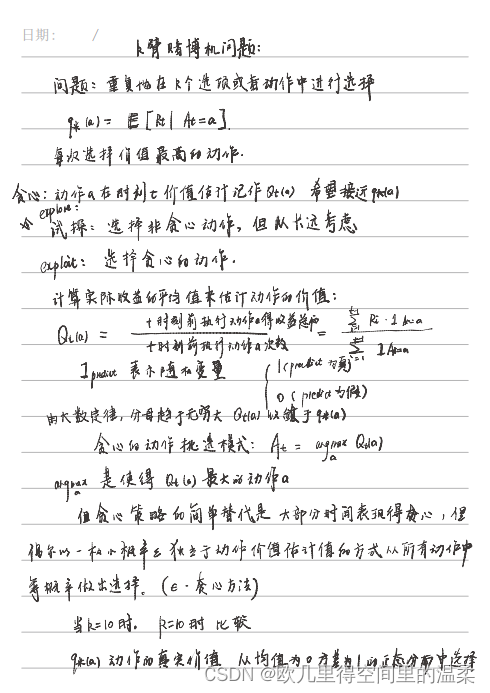
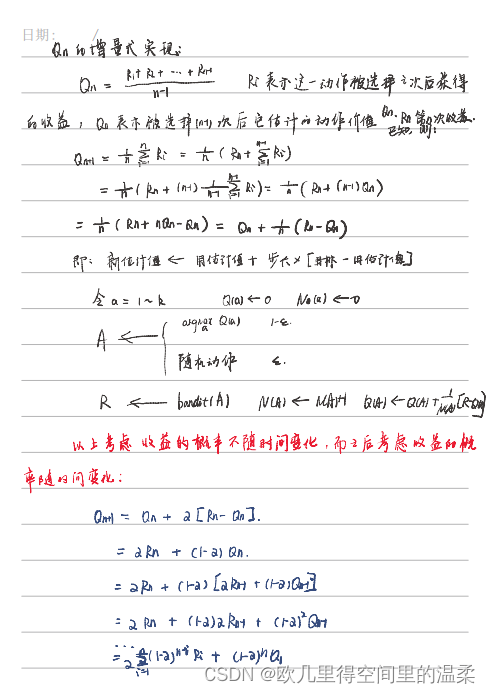


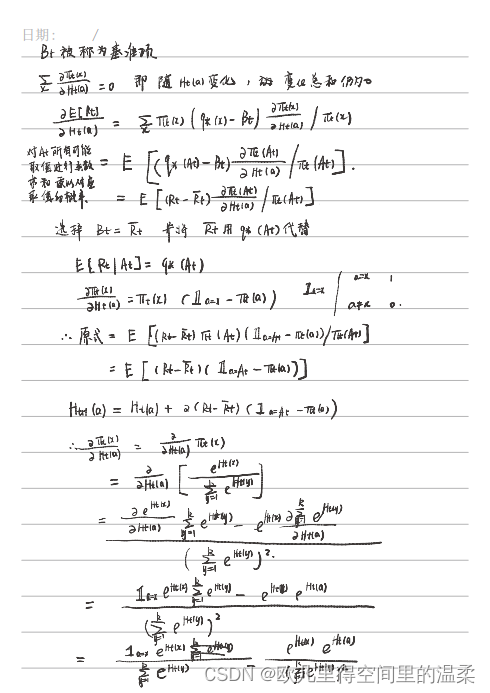

python代码实现:
#######################################################################
# Copyright (C) #
# 2016-2018 Shangtong Zhang(zhangshangtong.cpp@gmail.com) #
# 2016 Tian Jun(tianjun.cpp@gmail.com) #
# 2016 Artem Oboturov(oboturov@gmail.com) #
# 2016 Kenta Shimada(hyperkentakun@gmail.com) #
# Permission given to modify the code as long as you keep this #
# declaration at the top #
#######################################################################
import matplotlib
import matplotlib.pyplot as plt
import numpy as np
from tqdm import trange
matplotlib.use('Agg')
class Bandit:
# @k_arm: # of arms
# @epsilon: probability for exploration in epsilon-greedy algorithm
# @initial: initial estimation for each action
# @step_size: constant step size for updating estimations
# @sample_averages: if True, use sample averages to update estimations instead of constant step size
# @UCB_param: if not None, use UCB algorithm to select action
# @gradient: if True, use gradient based bandit algorithm
# @gradient_baseline: if True, use average reward as baseline for gradient based bandit algorithm
def __init__(self, k_arm=10, epsilon=0., initial=0., step_size=0.1, sample_averages=False, UCB_param=None,
gradient=False, gradient_baseline=False, true_reward=0.):
self.k = k_arm
self.step_size = step_size
self.sample_averages = sample_averages
self.indices = np.arange(self.k)
self.time = 0
self.UCB_param = UCB_param
self.gradient = gradient
self.gradient_baseline = gradient_baseline
self.average_reward = 0
self.true_reward = true_reward
self.epsilon = epsilon
self.initial = initial
def reset(self):
# real reward for each action
self.q_true = np.random.randn(self.k) + self.true_reward
# estimation for each action
self.q_estimation = np.zeros(self.k) + self.initial
# # of chosen times for each action
self.action_count = np.zeros(self.k)
self.best_action = np.argmax(self.q_true)
self.time = 0
# get an action for this bandit
def act(self):
if np.random.rand() < self.epsilon:
return np.random.choice(self.indices)
if self.UCB_param is not None:
UCB_estimation = self.q_estimation + \
self.UCB_param * np.sqrt(np.log(self.time + 1) / (self.action_count + 1e-5))
q_best = np.max(UCB_estimation)
return np.random.choice(np.where(UCB_estimation == q_best)[0])
if self.gradient:
exp_est = np.exp(self.q_estimation)
self.action_prob = exp_est / np.sum(exp_est)
return np.random.choice(self.indices, p=self.action_prob)
q_best = np.max(self.q_estimation)
return np.random.choice(np.where(self.q_estimation == q_best)[0])
# take an action, update estimation for this action
def step(self, action):
# generate the reward under N(real reward, 1)
reward = np.random.randn() + self.q_true[action]
self.time += 1
self.action_count[action] += 1
self.average_reward += (reward - self.average_reward) / self.time
if self.sample_averages:
# update estimation using sample averages
self.q_estimation[action] += (reward - self.q_estimation[action]) / self.action_count[action]
elif self.gradient:
one_hot = np.zeros(self.k)
one_hot[action] = 1
if self.gradient_baseline:
baseline = self.average_reward
else:
baseline = 0
self.q_estimation += self.step_size * (reward - baseline) * (one_hot - self.action_prob)
else:
# update estimation with constant step size
self.q_estimation[action] += self.step_size * (reward - self.q_estimation[action])
return reward
def simulate(runs, time, bandits):
rewards = np.zeros((len(bandits), runs, time))
best_action_counts = np.zeros(rewards.shape)
for i, bandit in enumerate(bandits):
for r in trange(runs):
bandit.reset()
for t in range(time):
action = bandit.act()
reward = bandit.step(action)
rewards[i, r, t] = reward
if action == bandit.best_action:
best_action_counts[i, r, t] = 1
mean_best_action_counts = best_action_counts.mean(axis=1)
mean_rewards = rewards.mean(axis=1)
return mean_best_action_counts, mean_rewards
def figure_2_1():
plt.violinplot(dataset=np.random.randn(200, 10) + np.random.randn(10))
plt.xlabel("Action")
plt.ylabel("Reward distribution")
plt.savefig('../images/figure_2_1.png')
plt.close()
def figure_2_2(runs=2000, time=1000):
epsilons = [0, 0.1, 0.01]
bandits = [Bandit(epsilon=eps, sample_averages=True) for eps in epsilons]
best_action_counts, rewards = simulate(runs, time, bandits)
plt.figure(figsize=(10, 20))
plt.subplot(2, 1, 1)
for eps, rewards in zip(epsilons, rewards):
plt.plot(rewards, label='$\epsilon = %.02f$' % (eps))
plt.xlabel('steps')
plt.ylabel('average reward')
plt.legend()
plt.subplot(2, 1, 2)
for eps, counts in zip(epsilons, best_action_counts):
plt.plot(counts, label='$\epsilon = %.02f$' % (eps))
plt.xlabel('steps')
plt.ylabel('% optimal action')
plt.legend()
plt.savefig('../images/figure_2_2.png')
plt.close()
def figure_2_3(runs=2000, time=1000):
bandits = []
bandits.append(Bandit(epsilon=0, initial=5, step_size=0.1))
bandits.append(Bandit(epsilon=0.1, initial=0, step_size=0.1))
best_action_counts, _ = simulate(runs, time, bandits)
plt.plot(best_action_counts[0], label='$\epsilon = 0, q = 5$')
plt.plot(best_action_counts[1], label='$\epsilon = 0.1, q = 0$')
plt.xlabel('Steps')
plt.ylabel('% optimal action')
plt.legend()
plt.savefig('../images/figure_2_3.png')
plt.close()
def figure_2_4(runs=2000, time=1000):
bandits = []
bandits.append(Bandit(epsilon=0, UCB_param=2, sample_averages=True))
bandits.append(Bandit(epsilon=0.1, sample_averages=True))
_, average_rewards = simulate(runs, time, bandits)
plt.plot(average_rewards[0], label='UCB $c = 2$')
plt.plot(average_rewards[1], label='epsilon greedy $\epsilon = 0.1$')
plt.xlabel('Steps')
plt.ylabel('Average reward')
plt.legend()
plt.savefig('../images/figure_2_4.png')
plt.close()
def figure_2_5(runs=2000, time=1000):
bandits = []
bandits.append(Bandit(gradient=True, step_size=0.1, gradient_baseline=True, true_reward=4))
bandits.append(Bandit(gradient=True, step_size=0.1, gradient_baseline=False, true_reward=4))
bandits.append(Bandit(gradient=True, step_size=0.4, gradient_baseline=True, true_reward=4))
bandits.append(Bandit(gradient=True, step_size=0.4, gradient_baseline=False, true_reward=4))
best_action_counts, _ = simulate(runs, time, bandits)
labels = [r'$\alpha = 0.1$, with baseline',
r'$\alpha = 0.1$, without baseline',
r'$\alpha = 0.4$, with baseline',
r'$\alpha = 0.4$, without baseline']
for i in range(len(bandits)):
plt.plot(best_action_counts[i], label=labels[i])
plt.xlabel('Steps')
plt.ylabel('% Optimal action')
plt.legend()
plt.savefig('../images/figure_2_5.png')
plt.close()
def figure_2_6(runs=2000, time=1000):
labels = ['epsilon-greedy', 'gradient bandit',
'UCB', 'optimistic initialization']
generators = [lambda epsilon: Bandit(epsilon=epsilon, sample_averages=True),
lambda alpha: Bandit(gradient=True, step_size=alpha, gradient_baseline=True),
lambda coef: Bandit(epsilon=0, UCB_param=coef, sample_averages=True),
lambda initial: Bandit(epsilon=0, initial=initial, step_size=0.1)]
parameters = [np.arange(-7, -1, dtype=np.float64),
np.arange(-5, 2, dtype=np.float64),
np.arange(-4, 3, dtype=np.float64),
np.arange(-2, 3, dtype=np.float64)]
bandits = []
for generator, parameter in zip(generators, parameters):
for param in parameter:
bandits.append(generator(pow(2, param)))
_, average_rewards = simulate(runs, time, bandits)
rewards = np.mean(average_rewards, axis=1)
i = 0
for label, parameter in zip(labels, parameters):
l = len(parameter)
plt.plot(parameter, rewards[i:i+l], label=label)
i += l
plt.xlabel('Parameter($2^x$)')
plt.ylabel('Average reward')
plt.legend()
plt.savefig('../images/figure_2_6.png')
plt.close()
if __name__ == '__main__':
figure_2_1()
figure_2_2()
figure_2_3()
figure_2_4()
figure_2_5()
figure_2_6()
输出的结果为:
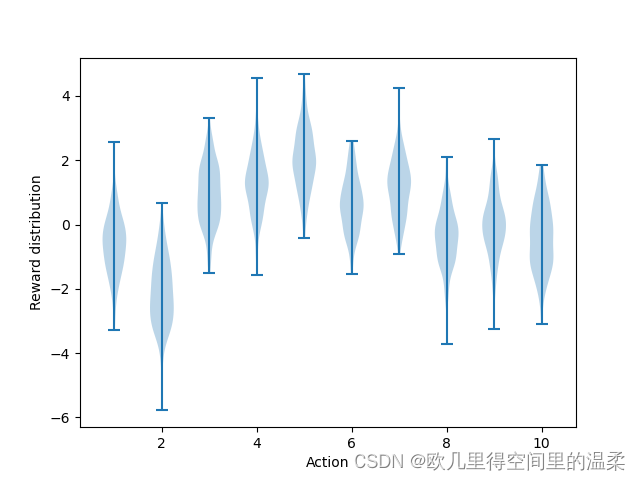
该图片展示了一个十臂赌博机的测试平台。这十个动作的真实值q*a分别由一个零均值单位方差的正态分布中产生。实际收益由均值为q*(a)的单位方差正态分布当中产生。所有采样方法都用采样平均策略来形成对动作价值的估计。

该图比较了贪心算法和贪心算法的对比,贪心算法在最初增长的略微快一些,但是随后稳定在一个较低的水平。从长远来看表现更糟,因为它经常陷入执行次优的怪圈。而
贪心算法相对与贪心算法的优点在于依赖于任务。为了找到最优的动作需要更多次的试探。
非平稳性是强化学习中遇到的最常见的状况,即使每一个单独的子任务都会随着学习的平稳推进而有所变化。这使得智能体的兼容也会不断变化。强化学习需要在开发和试探当中取得平衡。

图2.3显示了乐观的初始动作-价值估计在10臂赌博机测试平台上的运行成果。两种方法都采用了恒定步长的参数a=0.1
乐观初始值在平稳的问题当中非常有效,但它远非鼓励试探的普通有用的方法
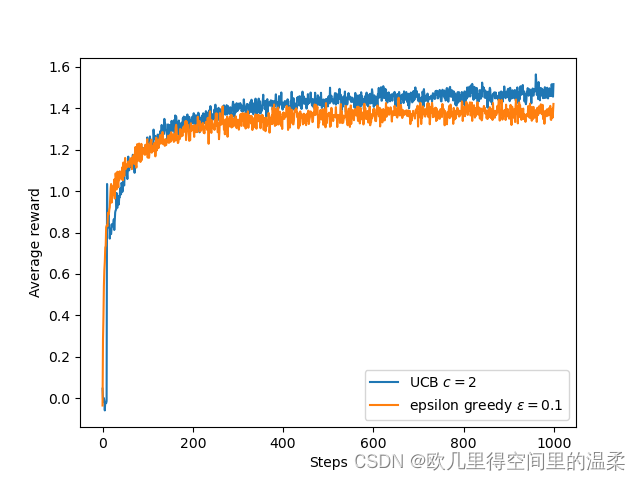
UCB算法在10臂测试平台上的平均表现,如图所示,,除了刚开始的k步随机选择尚未尝试过的动作外,在一般情况下UCB算法比ε贪心算法更好。
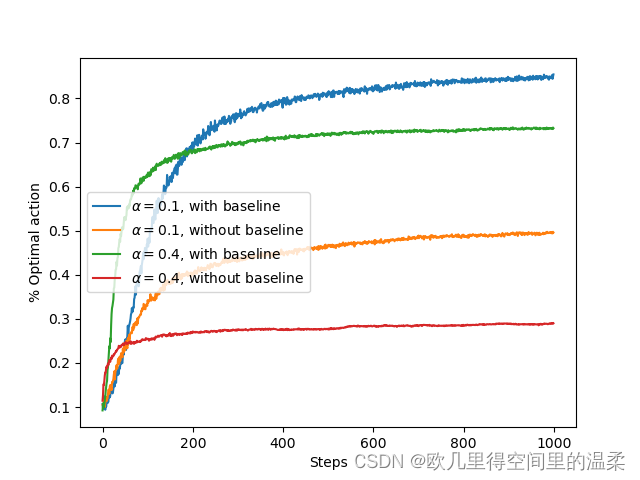
含有收益基准项和不含有收益基准项的梯度赌博算法在10臂测试平台上的平均表现。其中我们设定q*(a)接近与+4而不是0





















 4580
4580











 被折叠的 条评论
为什么被折叠?
被折叠的 条评论
为什么被折叠?








